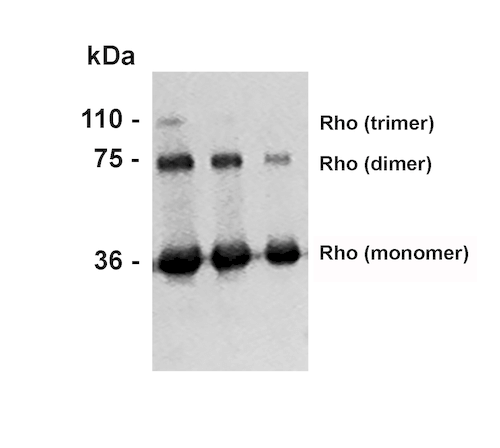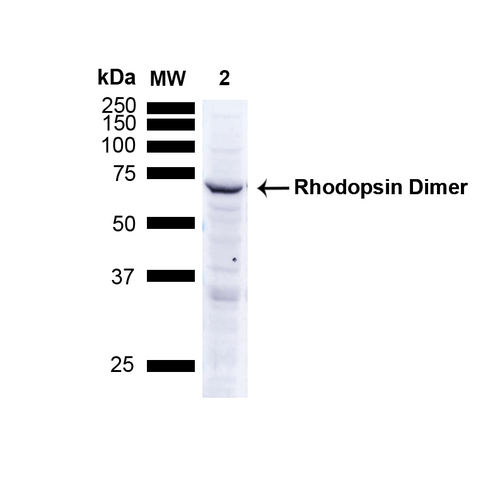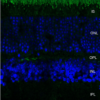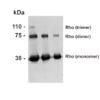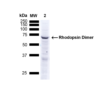Anti-Rhodopsin Antibody (56481)
$466.00
| Host | Quantity | Applications | Species Reactivity | Data Sheet | |
|---|---|---|---|---|---|
| Mouse | 100ug | WB,IHC,ICC/IF,IP,ELISA | All Mammalian Species Tested, Most Fish, Birds, Amphibians |  |
SKU: 56481
Categories: Antibody Products, Neuroscience and Signal Transduction Antibodies, Products
Overview
Product Name Anti-Rhodopsin Antibody (56481)
Description Anti-Rhodopsin Mouse Monoclonal Antibody
Target Rhodopsin
Species Reactivity All Mammalian Species Tested, Most Fish, Birds, Amphibians
Applications WB,IHC,ICC/IF,IP,ELISA
Host Mouse
Clonality Monoclonal
Clone ID 4D2
Isotype IgG1
Immunogen Bovine rhodopsin
Properties
Form Liquid
Concentration Lot Specific
Formulation PBS, pH 7.4; 50% glycerol, 0.09% sodium azide.
Buffer Formulation Phosphate Buffered Saline
Buffer pH pH 7.4
Buffer Anti-Microbial 0.09% Sodium Azide
Buffer Cryopreservative 50% Glycerol
Format Purified
Purification Purified by Protein G affinity chromatography
Specificity Information
Specificity This antibody recognizes the N-terminus of Rhodopsin from all mammalian species tested (human, mouse, rat, bovine, porcine), and most fish, birds, and amphibians.
Target Name Rhodopsin
Target ID Rhodopsin
Uniprot ID P02699
Gene Name RHO
Sequence Location Membrane, Cell projection, cilium, photoreceptor outer segment
Biological Function Photoreceptor required for image-forming vision at low light intensity. Required for photoreceptor cell viability after birth (By similarity). Light-induced isomerization of 11-cis to all-trans retinal triggers a conformational change that activates signaling via G-proteins (PubMed:10926528, PubMed:12044163, PubMed:11972040, PubMed:16908857, PubMed:16586416, PubMed:17060607, PubMed:17449675, PubMed:18818650, PubMed:21389983, PubMed:22198838, PubMed:23579341, PubMed:25205354, PubMed:27458239). Subsequent receptor phosphorylation mediates displacement of the bound G-protein alpha subunit by the arrestin SAG and terminates signaling (PubMed:1396673, PubMed:15111114). {UniProtKB:P08100, PubMed:1396673, PubMed:16586416, PubMed:16908857, PubMed:17060607, PubMed:17449675, PubMed:18818650, PubMed:21389983, PubMed:22198838, PubMed:23579341, PubMed:25205354, PubMed:27458239, PubMed:10926528, PubMed:11972040, PubMed:12044163, PubMed:15111114, PubMed:26526852}.
Research Areas Neuroscience
Background Rhodopsin is comprised of the protein opsin and a reversibly covalently bound cofactor, retinal. Opsin, made up of seven membrane-embedded alpha helices, binds retinal, a photoreactive chromophore, in a central pocket. In addition to being the pigment of the retina that is responsible for the formation of photoreceptor cells, rhodopsin conveys information stored in the chromophore to the surface of the molecule upon light absorption. Mutations in the rhodopsin gene lead to retinitis pigmentosa.
Application Images
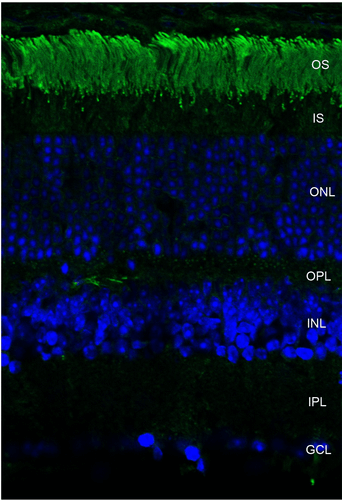



Description Immunohistochemistry analysis using Mouse Anti-Rhodopsin Monoclonal Antibody, Clone 4D2 (56481). Tissue: retina. Species: Mouse. Primary Antibody: Mouse Anti-Rhodopsin Monoclonal Antibody (56481) at 1:1000. Secondary Antibody: FITC Goat Anti-Mouse (green). Counterstain: DAPI (blue) nuclear stain. Localization: Staining of photoreceptor outer segment (OS). Other layers of the retina: IS – inner segment; ONL – outer nuclear layer; OPL – outer plexiform layer; INL – inner nuclear layer; IPL – inner plexiform layer; GCL – ganglion cell layer.

Description Western Blot analysis of Bovine photoreceptor membranes showing detection of Rhodopsin protein using Mouse Anti-Rhodopsin Monoclonal Antibody, Clone 4D2 (56481). Lane 1: MW ladder. Lane 2: 10 ug. Lane 3: 5 ug. Lane 4: 2.5 ug. Primary Antibody: Mouse Anti-Rhodopsin Monoclonal Antibody (56481) at 1:1000.

Description Western Blot analysis of Human A549 cells showing detection of ~38.9kDa Rhodopsin protein using Mouse Anti-Rhodopsin Monoclonal Antibody, Clone 4D2 (56481). Lane 1: MW ladder. Lane 2: Human A549 Cells 15 ug). Load: 15 ug. Block: 5% Skim Milk Powder in TBST. Primary Antibody: Mouse Anti-Rhodopsin Monoclonal Antibody (56481) at 1:1000 for 2.5 hours at RT with shaking . Secondary Antibody: Goat anti-mouse IgG:HRP at 1:1000 for 1 hour at RT with shaking . Color Development: Chemiluminescent for HRP (Moss) for 5 min in RT. Predicted/Observed Size: ~38.9kDa. Other Band(s): Band appears at ~75 kDa indicating detection of the Rhodopsin dimer.
Handling
Storage This antibody is stable for at least one (1) year at -20°C.
Dilution Instructions Dilute in PBS or medium that is identical to that used in the assay system.
Application Instructions Immunoblotting: use at 1-10ug/mL. A band of ~40kDa is detected.
Immunohistochemistry: use at 1-10ug/mL, paraffin-embedded and frozen.
Immunoprecipitation: use at 1-2ug per 100-500ug of protein.
These are recommended concentrations. User should determine optimal concentrations for their application.
Positive control: Rat eye lysate
Immunohistochemistry: use at 1-10ug/mL, paraffin-embedded and frozen.
Immunoprecipitation: use at 1-2ug per 100-500ug of protein.
These are recommended concentrations. User should determine optimal concentrations for their application.
Positive control: Rat eye lysate
References & Data Sheet
Data Sheet  Download PDF Data Sheet
Download PDF Data Sheet
 Download PDF Data Sheet
Download PDF Data Sheet


